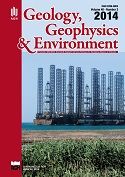Experimental testing of methanol sorption on selected coal samples from Upper Silesian Basin
DOI:
https://doi.org/10.7494/geol.2014.40.3.261Keywords:
coal, sorption, methanol, multisorption modelAbstract
This paper summarises the results of methanol sorption on three selected coal samples from Polish collieries. These coals differ in terms of their degree of metamorphism (coal rank), petrography and elemental composition. It was found out that during the sorption of methanol, the sorption capacity is closely related to the structure of the coal surface and the amount of sorbed polar substance tends to decrease with the higher degree of metamorphism. Experimental data were plotted as isotherms. Empirical measurements were supported by thermodynamic analysis of aliphatic hydrocarbons sorption. The procedure is based on the Multisorption Model (MSM) designed for describing small molecules sorption in different types of carbonaceous materials (hard coals, lignites, active carbons).
Downloads
References
Breus I.P., Mishchenko A.A., Potashev K.A. & Breus V.A., 2006. Description of organic compound vapor-phase sorption by geo sorbents: adequacy of the isotherm approximation. Colloids and Surfaces A, 276, 122–133.
Buczek B. & Wolak E., 2008. Potassium hydroxide modified active carbon for adsorptive refrigerators. Adsorption: Journal of the International Adsorption Society, 14, 283–287.
Cortés F.B., Chejne F., Mejia J.M. & Londono C.A., 2009. Mathematical model of the sorption phenomenon of methanol in activated coal. Energy Conversion and Management, 50, 5, 1295–1303.
Jodłowski G. & Wójcik M., 2013. Comparative analysis of sorption of small molecule hydrocarbons and polar substances in polish hard coals. Adsorption: Journal of the International Adsorption Society, 19, 813–819.
Kreiner K., Żyła M. & Baran P., 2007. Zmiany właściwości węgli kamiennych w procesie wygrzewania w atmosferze powietrza i azotu. Gospodarka Surowcami Mineralnymi – Mineral Resources Management, 23, special issue 3, 167–174.
Krzyżanowski A. & Żyła M., 2007. Characteristics of water, methanol and benzene vapours sorption properties of selected metamorphic types of hard coal. Gospodarka Surowcami Mineralnymi – Mineral Resources Management, 23, 4, 139–147.
Mathews J.P., van Duin A.C.T. & Chaffee A.L., 2011. The utility of coal molecular models. Fuel Processing Technology, 92, 4, 718–728.
Milewska-Duda J. & Duda J., 1993. Mathematical modeling of sorption process in porous-elastic materials. Langmuir, 9, 3558–3566.
Milewska-Duda J., Duda J., Jodłowski G.S. & Kwiatkowski M., 2000. A model for multilayer adsorption in microporous materials. Langmuir, 16, 7294–7303.
Orzechowska-Zięba A. & Nodzeński A., 2008. Sorption capacity of hard coals with respect to C6 to C8 hydrocarbons. Gospodarka Surowcami Mineralnymi – Mineral Resources Management, 24, 3/3, 245–254.
Stachurski J. & Żyła M., 1995. The Effects of Water and Methanol Sorption on Surface of Hard Coals of Different Carbonization. Archives of Mining Sciences, 40, 3, 317–327.
Takanohashi T., Terao Y. & Lini M., 2000. Sorption behaviors of methanol vapor by coal extracts and residues. Fuel, 79, 3–4, 349–353.
Tamas K., Vorholz J. & Maurer G., 2002. Molecular Simulation of the High-Pressure Phase Equilibrium of the System Carbon Dioxide-Methanol-Water. Journal of Physical Chemistry B, 106, 7547–7553
Van Krevelen D.W., 1965. Chemical structure and properties of coal. Fuel, 44, 229.
Wang N., Sasaki M., Yoshida T. & Kotanigawa T., 1997. Flow microcalorimetric study of methanol adsorption from n-hexane on coals. Energy & Fuels, 11, 6, 1293–1298.
Żyła M. & Kreiner K., 2006. Binarny charakter powierzchni węgla kamiennego. Górnictwo i Geoinżynieria, 30, 2, 19–34.
Downloads
Published
Issue
Section
License
Authors have full copyright and property rights to their work. Their copyrights to store the work, duplicate it in printing (as well as in the form of a digital CD recording), to make it available in the digital form, on the Internet and putting into circulation multiplied copies of the work worldwide are unlimited.
The content of the journal is freely available according to the Creative Commons License Attribution 4.0 International (CC BY 4.0)










